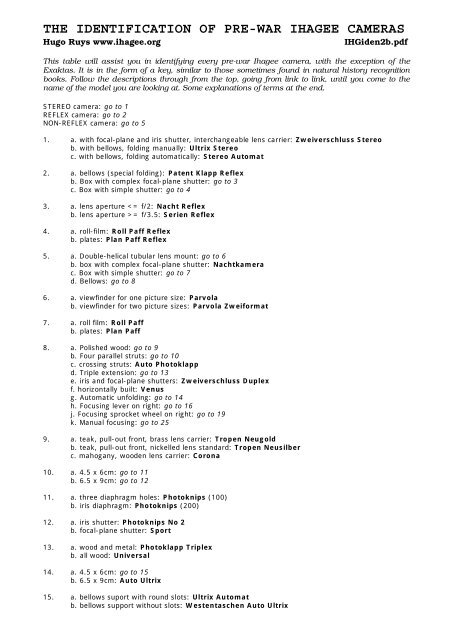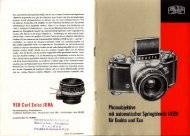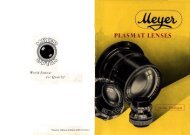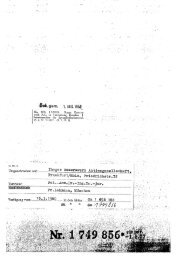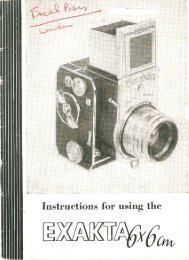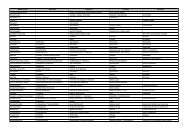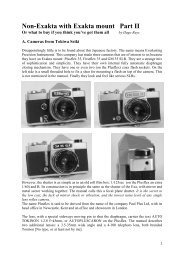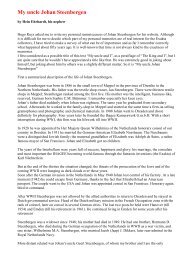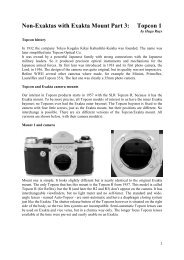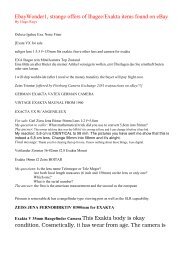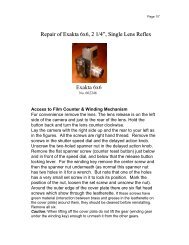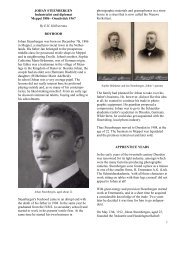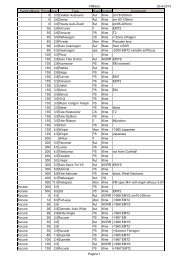the identification of pre-war ihagee cameras - Ihagee & Exakta ...
the identification of pre-war ihagee cameras - Ihagee & Exakta ...
the identification of pre-war ihagee cameras - Ihagee & Exakta ...
You also want an ePaper? Increase the reach of your titles
YUMPU automatically turns print PDFs into web optimized ePapers that Google loves.
THE IDENTIFICATION OF PRE-WAR IHAGEE CAMERAS<br />
Hugo Ruys www.<strong>ihagee</strong>.org IHGiden2b.pdf<br />
This table will assist you in identifying every <strong>pre</strong>-<strong>war</strong> <strong>Ihagee</strong> camera, with <strong>the</strong> exception <strong>of</strong> <strong>the</strong><br />
<strong>Exakta</strong>s. It is in <strong>the</strong> form <strong>of</strong> a key, similar to those sometimes found in natural history recognition<br />
books. Follow <strong>the</strong> descriptions through from <strong>the</strong> top, going from link to link, until you come to <strong>the</strong><br />
name <strong>of</strong> <strong>the</strong> model you are looking at. Some explanations <strong>of</strong> terms at <strong>the</strong> end.<br />
STEREO camera: go to 1<br />
REFLEX camera: go to 2<br />
NON-REFLEX camera: go to 5<br />
1. a. with focal-plane and iris shutter, interchangeable lens carrier: Zweiverschluss Stereo<br />
b. with bellows, folding manually: Ultrix Stereo<br />
c. with bellows, folding automatically: Stereo Automat<br />
2. a. bellows (special folding): Patent Klapp Reflex<br />
b. Box with complex focal-plane shutter: go to 3<br />
c. Box with simple shutter: go to 4<br />
3. a. lens aperture = f/3.5: Serien Reflex<br />
4. a. roll-film: Roll Paff Reflex<br />
b. plates: Plan Paff Reflex<br />
5. a. Double-helical tubular lens mount: go to 6<br />
b. box with complex focal-plane shutter: Nachtkamera<br />
c. Box with simple shutter: go to 7<br />
d. Bellows: go to 8<br />
6. a. viewfinder for one picture size: Parvola<br />
b. viewfinder for two picture sizes: Parvola Zweiformat<br />
7. a. roll film: Roll Paff<br />
b. plates: Plan Paff<br />
8. a. Polished wood: go to 9<br />
b. Four parallel struts: go to 10<br />
c. crossing struts: Auto Photoklapp<br />
d. Triple extension: go to 13<br />
e. iris and focal-plane shutters: Zweiverschluss Duplex<br />
f. horizontally built: Venus<br />
g. Automatic unfolding: go to 14<br />
h. Focusing lever on right: go to 16<br />
j. Focusing sprocket wheel on right: go to 19<br />
k. Manual focusing: go to 25<br />
9. a. teak, pull-out front, brass lens carrier: Tropen Neugold<br />
b. teak, pull-out front, nickelled lens standard: Tropen Neusilber<br />
c. mahogany, wooden lens carrier: Corona<br />
10. a. 4.5 x 6cm: go to 11<br />
b. 6.5 x 9cm: go to 12<br />
11. a. three diaphragm holes: Photoknips (100)<br />
b. iris diaphragm: Photoknips (200)<br />
12. a. iris shutter: Photoknips No 2<br />
b. focal-plane shutter: Sport<br />
13. a. wood and metal: Photoklapp Triplex<br />
b. all wood: Universal<br />
14. a. 4.5 x 6cm: go to 15<br />
b. 6.5 x 9cm: Auto Ultrix<br />
15. a. bellows suport with round slots: Ultrix Automat<br />
b. bellows support without slots: Westentaschen Auto Ultrix
16. a. Roll film: go to 17<br />
b. Plates: go to 18<br />
17. a. back<strong>war</strong>ds-leaning lens carrier: Ultrix (older design)<br />
b. straight lens carrier: Ultrix (newer design)<br />
18. a. 4.5 x 6cm: Microbie<br />
b. screw rise movement: Viktor<br />
c. 6.5 x 9cm, no movement: Westentaschen Viktor<br />
d. >= 9 x 12cm, manual movement: Ama 1928-37<br />
19. a. roll film: Ultrix Duplex<br />
b. plates: go to 20<br />
20. a. double bellows extension: go to 21<br />
b. screw rise movement: go to 22<br />
21. a. nickelled brass lens carrier: Luxus Duplex<br />
b. sideways-shifting distance scale: Patent Duplex<br />
c. fixed distance scale: Photoklapp Duplex<br />
22. a. special rounded lens carrier: go to 23<br />
b. normal lens carrier, frame viewfinder: Photoklapp Duplex 1930<br />
23. a. brilliant viewfinder: Patent Quido 1914<br />
b. small frame viewfinder: go to 24<br />
24. a. double extension: Taschen-Photoklapp B 1914<br />
b. single extension: Taschen-Photoklapp A 1914<br />
25. a. roll film: Ultrix Simplex<br />
b. plates: go to 26<br />
26. a. PHOTOREX on horizontal plate on lens standard: Photorex<br />
b. IHAGEE DRESDEN on lens plate: Derby<br />
c. cross slits between tracks: Ama 1925-26 and Derby 1926-27<br />
d. back<strong>war</strong>ds-leaning lens carrier, no movement: Derby<br />
e. raised distance scale on left: go to 27<br />
f. flat distance scale on left: go to 28<br />
27. a. no movement: Derby<br />
b. manual movement rise: Derby 1927-28<br />
c. manual movement rise and cross: Ama 1927-28<br />
28. a. manual movement, rise and cross: Derby 1928-37<br />
b. cylindrical grips, no rods: Rekord<br />
c. globular grips and central cross-movement screw: go to 29<br />
29. a. brilliant viewfinder centered: Weltrekord A<br />
b. brilliant viewfinder on left: Weltrekord B<br />
Explanation <strong>of</strong> terms<br />
Brilliant viewfinder, with two lenses and mirror<br />
Duplex, double extension<br />
Iris shutter, shutter inside <strong>the</strong> lens (as opposed to focal-plane shutter)<br />
Lens carrier, vertical plate to which lens and shutter are attached<br />
Lens stadard, vertical supports <strong>of</strong> <strong>the</strong> lens carrier<br />
Movement, capability <strong>of</strong> lens carrier to move up and down, or sideways, or both<br />
Rise and cross, up and down and sideways<br />
Screw movement, movement controlled by screw (as opposed to manual push and pull)<br />
Zweiformat, double-format<br />
Viktor, later called Victor<br />
Left and right as seen when using <strong>the</strong> camera<br />
Special lens carrier


